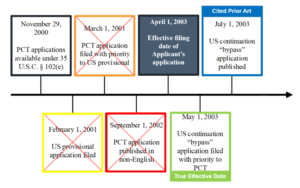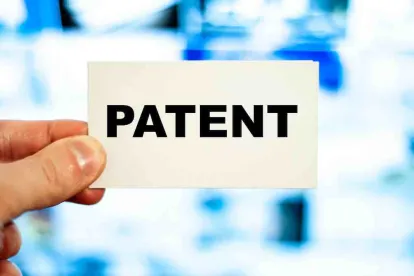Although America Invents Act (AIA) patent practice is entering its 8th year, many pre-AIA patent applications remain pending. This requires practitioners to stay attentive as to whether examination is being conducted under pre-AIA practice, and to ensure that the pre-AIA rules are correctly applied. In this regard, to avoid unnecessarily ceding claim scope to disqualified prior art, it is imperative for practitioners to verify whether U.S. Patent and Trademark Office (USPTO) Examiners are properly applying pre-AIA 35 U.S.C. § 103 rejections. This can be challenging since the priority chain for a prior art reference can become quite complex, especially when cited references involve priority to PCT applications, non-English disclosures, and provisional applications.
As explained in MPEP § 1896, applicants may claim priority to a PCT application in two different ways, with the most common being to file a national phase application under 35 U.S.C. § 371. However, pursuant to 35 U.S.C. § 365(c), a regular national application filed under 35 U.S.C. § 111(a) and 37 CFR 1.53(b) (providing for “child” or “continuation applications”) may claim the benefit of the filing date of an international application which designates the United States, without completing the requirements for entering the national stage under 35 U.S.C. § 371. An application filed in this way, as a child U.S. application of a PCT application, is known as a “bypass” application.
Understanding this difference is important, because, upon publication, a patent application can be cited as prior art under certain circumstances. How that publication claims its priority benefit may determine whether a rejection under pre-AIA 35 U.S.C. § 103 has been properly made.
The Manual of Patent Examination Procedure (MPEP) sets out guidelines and examples to illustrate the effective prior art dates of potential prior art references. Similar to Example 8 in MPEP § 2136(I) and as shown in the diagram below, suppose an Examiner cites a U.S. pre-grant publication of a “bypass” continuation application filed May 1, 2003 (green) and published July 1, 2003 (blue), which claimed priority to a PCT application filed March 1, 2001 (orange) and published September 1, 2002 (red) in a non-English language.

Continuing up the priority chain, the PCT application claimed priority to a U.S. provisional application filed February 1, 2001 (yellow). In rejecting an application filed April 1, 2003 (black box), an Examiner might assert that the effective filing date of the U.S. pre-grant publication (blue) is the filing date of the PCT application (orange), or even the filing date of the U.S. provisional application (yellow). This would be incorrect.
As MPEP § 2136.03(II)(A)(A) explains, the PCT filing date (orange) is not to be treated as a U.S. filing date in this case. Instead, the U.S. Pre-grant publication may only be applied under pre-AIA 35 U.S.C. 102(e)(1) and (2) as of the filing date of the continuation “bypass” application claiming the benefit of the PCT application — in this case, May 1, 2003 (green).
While the filing of the “bypass” application may give the appearance that the effective filing date of the U.S. pre-grant publication is February 1, 2001 (yellow), such that it pre-dates the Applicant’s filing date, the true effective filing date of this U.S. pre-grant publication under pre-AIA 35 U.S.C. 102(e)(1) and (2) is actually May 1, 2003 (green), as shown in the timeline above.
As a result, for the example application with an effective filing date of April 1, 2003, the Examiner cannot properly make a rejection under pre-AIA 35 U.S.C. § 103 citing the “bypass” application because its true effective date is after the application’s filing date.
The above is just one example of the possible pitfalls that applicants should be aware of when analyzing an Examiner’s prior art rejections. It is therefore important that applicants remain cognizant of the AIA status of their applications, and carefully review the chain of priority of any prior art reference to determine its proper effective date.





 />i
/>i

